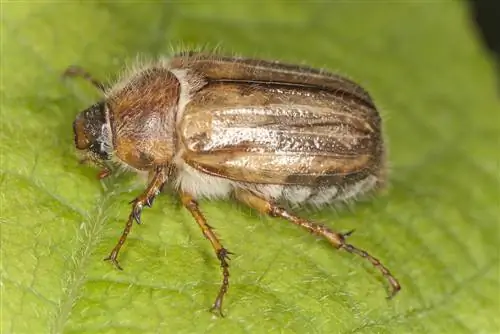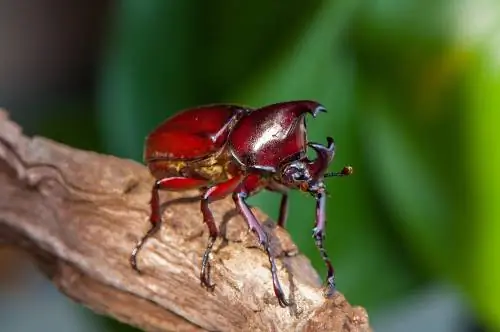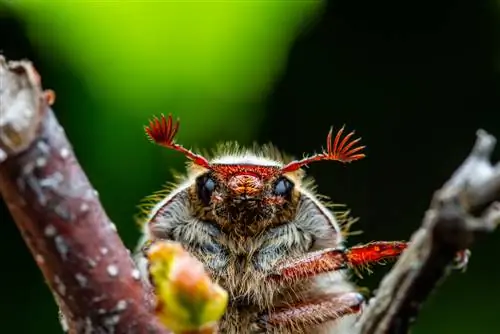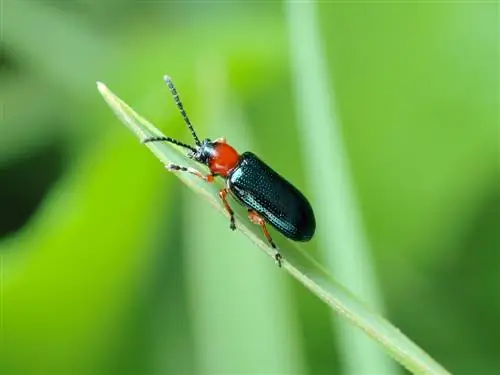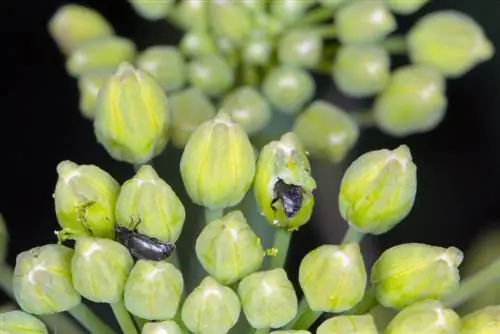- Author admin [email protected].
- Public 2023-12-16 16:46.
- Last modified 2025-01-23 11:19.
The June beetle is the smaller brother of the May beetle. Unlike its related species, the June beetle causes less damage. These can vary regionally and can be large in some places. Targeted and environmentally friendly control is often the only way out.
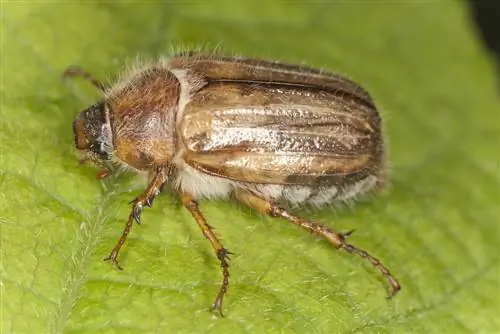
Fighting June beetles
Fighting adult beetles is often not effective because the grubs continue to develop in the soil. To stop the spread of the beetles, you must take targeted measures against the grubs.
The larvae need a humidity of 100 percent. They cannot survive on the soil surface because they dry out immediately. If you discover the first signs of a pest infestation, you should loosen and aerate the lawn thoroughly. You can completely destroy the larval population with a milling machine. However, this destroys the entire soil structure, which is why other control methods make more sense.
Nematodes
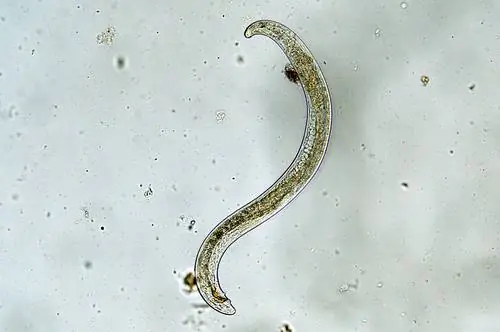
Nematodes are tiny worms that eat the June beetle larvae from the inside
An effective remedy is special roundworms that are used against June beetles. The microscopic creatures are only 0.6 millimeters long and occur naturally in the soil. Of the nematodes, the species Heterorhabditis bacteriophora is one of the natural enemies of the June beetle.
Fighting with nematodes only makes sense in the first larval stage, as the grubs are no longer susceptible to the nematodes after they molt. The nematodes penetrate the living larvae, feed on the cell tissue and multiply in the organism. Within two days the grub dies and the nematodes leave the host to infest further larvae. It takes up to six weeks for this control method to achieve maximum success.
Tip
Nematodes should be applied between August and September. The earlier you start fighting, the easier it is for the nematodes to multiply.
Application
Specialist retailers offer special powders containing live nematodes that are mixed with water and applied to the affected areas. Always mix the entire contents of the bag with water as the nematodes are not evenly distributed throughout the powder. Stir the solution thoroughly before bottling so that the nematodes do not settle at the bottom.
Pour the required amount into a watering can and pour the solution onto the affected areas. If the soil is very dry, it should be watered beforehand. The nematodes require moist conditions and dry out quickly. To prevent organisms from sticking to blades of grass, you should water the area afterwards.
Good to know:
- Nematodes need a soil temperature above twelve degrees Celsius
- A drop in temperature at night does no harm
- great light sensitivity
- apply only in the morning or evening
- Roundworms reproduce in two to three weeks
- Keep the soil evenly moist during this time
Parasitic fungi against June beetles
The beetle larvae can be controlled biologically using special fungi that live parasitically. Fungi of the genus Metarhizium are used, with the species Metarhizium anisopliae being most commonly used as a control agent. When it comes into contact with the grubs, its spores settle on its outer skin. These germinate and pierce the tissue with the hyphae.
The fungus develops inside the larva so that it dies after a few days. Spring and autumn are indicated as favorable treatment periods, although the temperatures should be warm. Then the grubs are looking for food in the upper layers of the soil.
Application:
- Mix mushroom spores with sterilized barley grains
- Sprinkle the mixture on the ground
- work well
- Water the lawn generously
Beauveria brongniartii
This parasitic fungus has a similar lifestyle to Metarhizium anisopliae. Both fungi have specialized on a few hosts. The use of Beauveria brongniartii remains ineffective against the June beetle. However, this is effective in combating cockchafers.
Pyrethrum
The Caucasian insect flower (Tanacetum coccineum) develops a phytochemical that is intended as a defense and has been extracted by humans for many centuries. The active ingredient pyrethrum has a fatal effect on insects because it spreads through the nervous system and damages the irritant pathways. The contact poison only works if the beetles are sprayed directly. They stagger, fall from the leaves to the ground and can die. Many insecticide manufacturers use the substance for their products that are used to kill pests.
Tip
The spray makes no exception to beneficial insects. Pyrethrum is fatal to all insects and should therefore not be used in the garden.
What to do against June beetles in the apartment?
June beetles orientate themselves on light sources during their twilight and night flights, because these make the silhouettes of trees and bushes stand out against the horizon. They can also get lost in apartments if the windows are wide open and there is light inside. Try to capture the animals with a screw-top jar and release them outside again. There is no natural way to get rid of the beetles.
Build your own trap
Scent traps that contain a cocktail of pheromones are often used to catch garden chafers. This serves as an attractant and attracts male beetles that are looking for a partner. The effectiveness of such traps on June beetles is controversial. While some garden owners report success, attempts at attracting them in other gardens remain unsuccessful. If you want to build your own trap, you should take advantage of the beetle's way of life. Use artificial light sources as attractants.
How to build a June beetle trap:
- cut a 1.5 liter plastic bottle in half
- Place the upper part upside down into the lower end
- hang vertically at tree or shrub height
- attach a light source behind it
Tip
You can paint the bottle parts except the bottom green to simulate foliage. Additionally, enlarge the entrance opening with a cut funnel so that the beetles do not fall to the ground so easily.
Preventing June beetles
June beetles feel particularly comfortable in the lawn if it has open spaces and a warm, dry microclimate. To make the areas unattractive for laying eggs, you have to worsen the living conditions for the beetle. To prevent the females from laying their eggs in the ground, the turf must be as dense as possible. This is possible with regular care. Start with the first mowing in spring when the lawn has grown about eight centimeters high.
Lawn care throughout the year:
- scarify in spring
- fertilize afterwards
- mow weekly
- don’t cut too deep
Laying lawn protection
In warm regions, so-called lawn protection fabrics are used so that the uncontrolled spread can be contained. These mats are laid out at a depth of ten centimeters. This is followed by a layer of earth with grass seeds or turf. The material is weather-resistant and does not rot. Prices can vary and are around three euros per square meter.
How it works
Old larvae cannot reach the plant roots from the deeper layers of soil in spring and young larvae cannot retreat to deeper layers of soil to overwinter, so they freeze to death. The mats also prevent moles from digging up the soil.
Spread the foil
You can prevent female beetles from laying their eggs in the meadow. To do this, you must lay out foil or garden fleece on the lawn during the flight period so that the June beetles cannot land on the substrate. This measure only makes sense in small gardens and must be repeated every evening for several weeks. To avoid damaging the lawn, the film should not be left on the area all day.
What are June beetles?
Behind the June beetle (English: june beetle or summer chafer) hides the species Amphimallon solstitiale, which is also known as the ribbed curlew beetle. It belongs to the scarab beetle family and is closely related to the May beetle. June beetles reach a size of between 14 and 18 millimeters and have yellow-brown to brown wing coverts. The crown and pronotum are darker in color than the rest of the body.
What gave the beetles their official German name is the pattern on the elytra. There are three raised ribs on each side. What is striking are the long antennae, whose attached compartment is divided into three parts when you look closely. The beetles are hairy on the pronotum and under the cover wings.

Reproduction and development stages
The beetles mate in June. The female lays up to 35 eggs in sandy soil in July. They fly back to the places where they hatched to lay their eggs. Shortly afterwards the female dies. The first larval stage hatches between July and August, depending on when the eggs are laid.
Once a larva has hatched, it crawls into the substrate. To overwinter, the larvae molt so that they survive the winter in the second larval instar. In order to be protected from the frosty temperatures, the grubs retreat below the frost line of the ground.
In June of the second year, the grubs shed their skin in order to migrate back near the roots in the third larval instar. In this stage the larvae survive the coming winter in deeper layers of the earth. In the third year, the grubs transform into a pupa from which the adult beetles emerge in June. In northern regions, full development takes up to four years.
The larval stages are this big:
- first stage: about one centimeter
- second stage: two to three centimeters
- third stage: up to five centimeters
Enemies
The natural enemies of flying beetles include bats. The insectivorous mammals are active when the June beetles are also at their peak activity. The larvae are eaten by shrews and moles. The spread of June beetles is regulated naturally in natural gardens with different habitats in which many different types of insects find an optimal habitat.
Enemies living in and on the ground:
- Arthropods like stone crawlers
- Paradise fly
- Dagger wasps
- Larvae of various ground beetles
Danger of confusion with other beetles
There are some species of beetles that can easily be confused with the June beetle. Since some other scarab beetles are also called June beetles, there are often misunderstandings. However, a clear species delimitation is important because control measures can also endanger useful beetles.
Cockchafer and June beetle in comparison

The cockchafer (pictured here) is less hairy than the June beetle
The cockchafer most widespread in Central Europe is the field cockchafer (Melolontha melolontha). It also belongs to the scarab beetle family and inhabits open landscapes. Its larvae require well-loose soil with moist conditions. They often find optimal conditions in gardens, parks and meadows.
| Cockchafer | June beetle | |
|---|---|---|
| Size | 22 to 32 millimeters | 14 to 18 millimeters |
| wing covers | light or dark reddish brown | yellow brown |
| Hair | fitting white, never opaque | brownish, densely bristly |
| Longitudinal ribs | four per elytra | three per elytra |
Differentiation of larvae
The grubs of May and June beetles are creamy white to white-yellow in color and have a brown head capsule. This makes it difficult to distinguish the species from one another, which makes targeted control difficult. They have a typical posture that is reminiscent of a “c”. In order to separate the two species from each other, the last abdominal segment must be examined in more detail. In cockchafers, this last segment has a ring-shaped transverse furrow, so that the segment appears to be divided into two.
Another important difference between the June beetle and the cockchafer is the anal cleft on the last segment. In the case of the June beetle larvae, this is deeply cut and fanned out into three rays upwards. Cockchafer larvae have a shallow anal cleft.
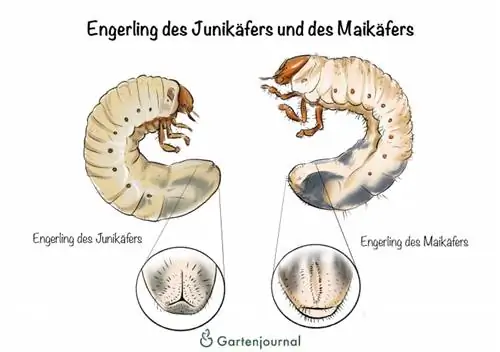
July beetle
The species Anomala dubia, also known as the metallic July beetle, is hidden behind the July beetle. The reason for this name is the metallic shine of the head and pronotum, which shimmer green. Its elytra are light brown in color. This species also belongs to the scarab beetles and is between twelve and 15 millimeters long.
A typical identifying feature is the lack of hair, which distinguishes it from other garden chafers. Like the June beetle, this species also lays its eggs in sandy soil. The grubs eat roots of grasses and trees, while the beetles feed on willow and birch leaves.
July beetle activity:
- Flight time between May and August
- sunny days are preferred
- flies at dusk
Rhizotrogus marginipes
This scarab beetle is sometimes referred to as the June beetle because there is no official German name for it. This species differs from the actual June beetle in that it has barely visible stripes on the cover wings. The pronotum is dark colored and coarsely to finely dotted. The rest of the body has a reddish-yellow to brownish color. Rhizotrogus marginipes has adjacent hair, while the June beetle is noticeably hairy and has long cilia on the edges of the elytra.
When the beetle flies:
- between June and July
- in the evening hours
- preferred on cool days
What do June beetles eat?
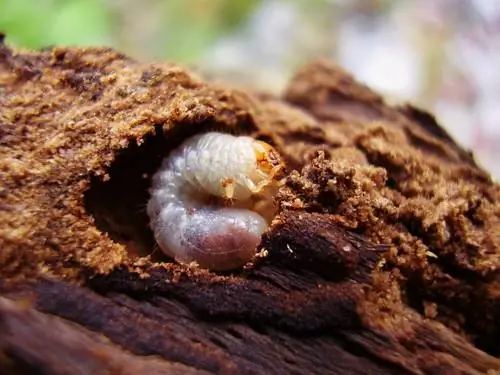
The larvae even eat soft wood
The larvae's diet includes fine roots of grasses, wild herbs and ornamental plants in the garden. They do not specialize in any plant species and eat the roots of cyclamen, Virginia creeper, primroses or azaleas. The roots of woody plants such as roses and rhododendrons or freshly planted deciduous trees and pines are also eaten by the grubs. Adult June beetles eat leaves and flowers of deciduous trees such as fruit trees.
Where do June beetles live?
June beetles live on the edges of forests and on farmland. They prefer semi-open landscapes and can therefore also be found in gardens or parks with trees and in avenues. Southern Norway and central Sweden represent the northern distribution limit of this scarab beetle because it requires warm temperatures. June beetles only occur locally in the mountains. The females look for sandy and well-loose soils to lay their eggs. They avoid damp locations.
When do June beetles appear?
The June beetle's flight period extends from June to July, which is why the species got its German common name. The beetles are not diurnal and prefer warm temperatures. On warm summer evenings, the beetles go looking for food and mates. In particularly mild winter months, the larvae pupate at the end of winter, so that in some years June beetles can appear in April. They swarm out in large numbers, which is why they are often associated with a plague of beetles. About two thirds of flying beetles are male.
Male June beetles swarm around garden furniture, trees and bushes on warm summer evenings around June 21st because they are looking for a partner.
Excursus
Flying June Beetle
These scarab beetles are considered clumsy fliers because they often land unintentionally on clothing. This is because the animals orientate themselves on the higher silhouettes in front of the clear horizon. People can easily be confused with a tree. Another reason for the clumsy behavior is the comparatively small wings, which have to carry a lot of weight. The maneuverability during flight suffers from this unequal ratio.
Harmful and useful larvae
The adult June beetle poses no danger to trees, even if they swarm out in large numbers and eat leaves. After a few weeks, the beetles disappear as quickly as they appeared, so that deciduous trees and fruit bushes can recover from the damage caused by their feeding in a short time.
However, the larvae can affect lawns or flower beds. New plantings of trees are also threatened. If the grubs eat roots, the affected plants can no longer supply themselves with sufficient nutrients and water. They die off over time. Since the grubs of various harmful and beneficial species are very similar, you must distinguish between the species before combating them.
| Engerling | Coloring | Food | Special features |
|---|---|---|---|
| rose beetle | white with grayish shading | dead plant remains | stretched, crawling on the back |
| Rhino Beetle | whitish with light brown head | dead plant remains | up to 10 cm long |
| Garden leaf beetles | whitish with brown head | living plant parts | stretched, crawling on stomach |
malicious image
The greatest danger to the plants comes from the larvae in the third instar, as they eat a particularly large amount of food. The first warning signal is stunted grass growth that occurs in certain spots in the lawn. Circular spots with dried grass are a typical indication of grubs in the soil. The dead areas can be peeled off with your bare hand, revealing the larvae's nests.
Consequential damage:
- troubled ground by wild boars
- areas picked by birds
- Molehills
Excursus
June beetles and culture
Children are already confronted with the June beetle in kindergarten and elementary school. It serves as a template for coloring pages and appears in mnemonics that help children discover the months. In order to allay the fear of the animals, many schools carry out catching activities. Children can examine the beetles closely and learn about the distinguishing features of the May beetle. With the help of clipart or collages, children can depict the brown-colored curlew beetles in their natural habitat.
Frequently asked questions
Are June beetles dangerous?
Flying June beetles pose no danger, even if you pick up the beetles. Many people are afraid when the beetles fly directly towards them. But the fear of a bite is unfounded. The animals do not sting, are not poisonous and do not suck blood. Even if your pet has eaten a June bug, you don't have to worry. Cats like to eat June bugs as a snack when they are pursuing their natural hunting instincts.
Do June beetles build nests?
The large number of beetles appearing on warm summer evenings suggests that June beetles live in nests. But the beetles don't build shelter. They lay their eggs on bare soil if it is sandy enough. After the larvae hatch, they retreat into the substrate for further development. The adult beetles eventually crawl back out of the ground.
When do June beetles disappear?
The only reason for a beetle to survive is to reproduce, which is why their lifespan is very short. After this has been completed and the females have laid their eggs, the June beetles die within the same year.
Where does the June beetle come from?
The scarab beetles love warmth and inhabit open habitats that are warmed by the sun. They visit gardens more often and are not afraid of built-up areas as these are more protected and retain heat. In order for the animals to survive, patchy lawns, sandy soils as well as trees and bushes are important as sources of food.
How long do June beetles stay?
June beetles love warmth, which is why they mainly appear in the summer months. If the winter months are particularly mild, the larvae can pupate as early as April. The adult beetles then fly out much earlier to look for food and find a mate. They don't fly in rainy weather. The mass occurrence lasts a few weeks.
How long do June beetles live?
The beetles don't get very old. After they hatch, the beetles are expected to live four to six weeks. This range may vary slightly depending on the weather.
Where do June beetles live during the day?
So that the clumsy flyers are better protected from predators such as birds and mammals, they have shifted their activity to dusk. Your flight lasts a few hours. Afterwards, June beetles hide again in the low vegetation, where they spend the day.

